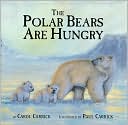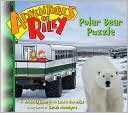As you probably gathered from Monday's post, Global Warming has had a significant impact on polar bears. Today we'll be exploring that whole concept in a child-friendly manner, ultimately allowing them to see the little things they can be doing to help save the polar bears!
 Carrick, Carol.
Carrick, Carol.The Polar Bears are Hungry.
2002.
Clarion Books.
Review copy borrowed from local library.
Written in lyrics, Carol Carrick approaches the delicate topic of global warming in a way most appropriate for the youngest of children, without being to graphic or descriptive in a way that might scare them. The mother polar bear and her two cubs set out in search of food, successful at first. But as the water temperatures warm, readers quickly discover the impact that warmer water temperatuCarores have on creatures that so depend on any icy environment for successful hunting. For the youngest of children handling this book (ages 4-7), the ending is certainly appropriate - seemingly happy. Although, in reality, the majority of polar bears don't recover from these hunting troubles as quickly as this mother and cub team did!
This is a wonderful book that focuses on the topic of global warming's impact on the polar bear population. The non-fictional way in which it is written makes it appealing and easy to read for young children. Coupled with a discussion and the activity found below, this book will certainly get your child(ren) thinking along the lines of how they can do their part to help prevent future global warming!
 Lumry, Amanda and Laura Hurwitz.
Lumry, Amanda and Laura Hurwitz.Adventures of Riley: Polar Bear Puzzle.
2008.
Eaglemont Press.
Review copy borrowed from local library.
Nine-year old Riley embarks on yet another adventure with Uncle Max, Professor and Senior Field Biologist. This time, the pair is headed to Churchill, Canada...
Dear Riley,Upon arriving in Churchill, readers will follow alongside Uncle Max, Aunt Martha, Cousin Alice and Riley to begin learning of the puzzling factors contributing to the decline in the polar bear population.
We're worried about polar bears, the
Arctic's largest predators! Every year they're
becoming skinnier and weaker, and giving birth
to fewer cubs, and scientists aren't sure why.
Aunt Martha, Cousin Alice, and I are going
to the Arctic town of Churchill,
Canada, to get to the bottom of this
mystery. What do you say, Riley -
will you "bear" with us?
Uncle Max
This was a very clever approach to handling such a mind-boggling topic for children. The whole concept of global warming is extremely difficult for a young child to understand, but I felt this book approached it in an appropriate manner! As for this book being part of a series? I'm truly amazed it's taken me this long to discover! The book was wonderful and I'm hoping to try and highlight a few more of them throughout the course of 2010!
Learning/Reading Activity:
- Talk to you child about global warming. Address information such as: What is global warming? What causes global warming to happen? How does global warming effect animals? People? Plants? Then, send your child on a webquest (having bookmarked several appropriate child-friendly sites on the topic) to find out what he/she can be doing to prevent further global warming. Then, using the information he/she finds, ask your child to create a poster titled "Solving the Polar Bear Puzzle," in which he/she shares with others ways in which they can impact the amount of global warming that takes places - all in an effort to save the polar bears.

If you're interested in finding out more information about any of the books reviewed or if you'd like to purchase the books, click the cover image for a link to Amazon.com. I am an Amazon Affiliate, so any purchases you make after clicking these images will result in my receiving a small percentage of the sale price!








0 comments:
Post a Comment